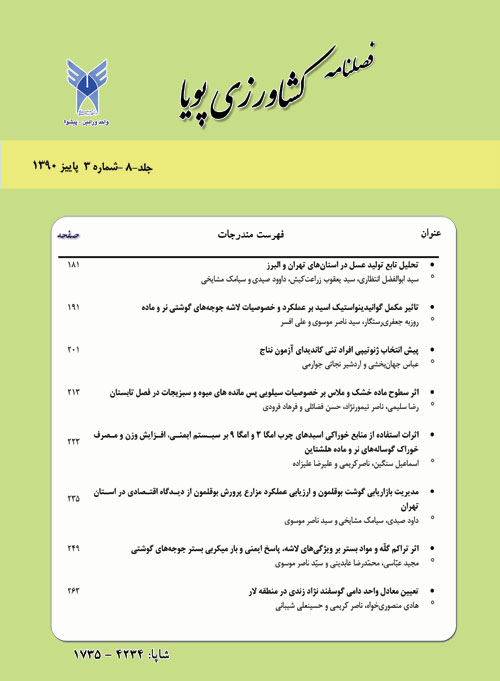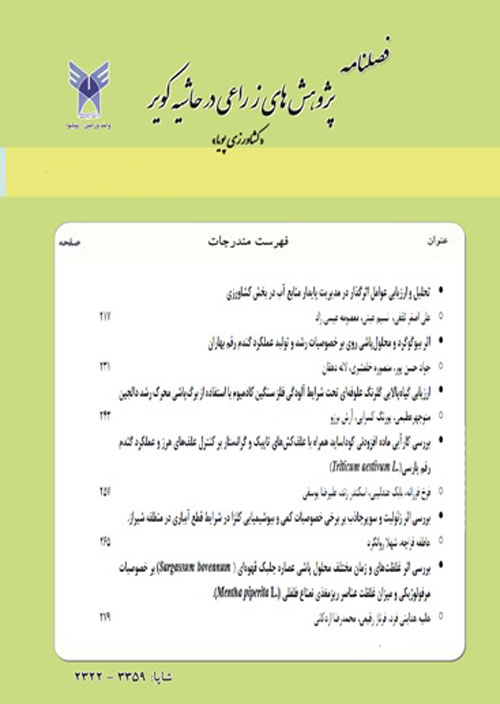فهرست مطالب

فصلنامه پژوهشهای زراعی در حاشیه کویر
سال هشتم شماره 2 (تابستان 1390)
- تاریخ انتشار: 1390/05/26
- تعداد عناوین: 7
-
Page 99The milk casein genes linked to the major technical features of milk such as coagulation and flocculation characteristics of milk and cheese production, so have been taken into consideration in these genes polymorphisms. Kappa-Casein with other casein genes (alpha-s1, alpha-s2 and beta casein), encode the major milk proteins and been considered as candid genes to improve the quality and quantity aspects of milk. The aim of this study was to detection of polymorphism at 660 bp region of exon 4 of the kappa-Casein gene in Mahabadi goats breed. Due to this purpose, a total of 100 Iranian Mahabadi goats bloods were collected. PCR-RFLP technic with HaeIII restriction enzyme with two primes Kap2F and Kap2R were used to identify A or E alleles and to detect polymorphism in exon 4 of the kappa-Casein gene. PCR amplified product was observed as 660 bp and the restriction analysis by HaeIII enzyme produced two fragments of 430 bp and 230 bp that exhibiting the presence of the kappa-Casein A allele and AA homozygote genotype in all samples. According to the results, the kappa-Casein monomorphism pattern observed in this study at locus exon 4 of the kappa-Casein gene in the tested Mahabadi goats population.Keywords: Polymorphism, kappa, Casein gene, PCR, RFLP, HaeIII, Mahabadi goat
-
Page 107In order to compare the effects of four ideal profiles of amino acid on broiler performance and immune system, this study conducted in randomized complete block design with four treatments N.R.C. (1994), Feedstuff (2008), Evonik-Degussa (2006) andCobb 500 Nutrition Supplement (2008) and four blocks each in 42 days feeding. 384 day old Cobb 500 chicks were used. At the end of each feedingphase (10, 24 and 42 days), birds and feed intake were weighted. In 21stand 42nd days from each pen 3 birds were selected and blood sampled to observe the effect of profiles on blood titer (HI) against Newcastle virus. At the end of trial, from each pen 3 birds were slaughtered and carcass analysis was done. Results showed no significant difference in weight gain, feed intake, feed conversion ratio, blood titer on 21st day and carcass compartements percentage among treatments.Just N.R.C. with highest blood titer, showed significant difference (P≤0.05) on 42nd days with Evonik-Degussa. Also from economic point, N.R.C. showed lowest expense for per kilogram live weight and the most per hen selling income.Keywords: Broiler chicken, Ideal amino acid, Performance, Immune system, Cobb 500 strain
-
Page 139The objective of this study was to evaluate the effects of Protexin (7 strains of different bacteria plus 2 strains of fungi, totally 2×109 CFU/g), Probio-Sacc (Saccharomyces cerevisiae MUCL/BCCM 39885, 1.5×1010 CFU/g) and their synergistic effects on performance and blood metabolite of suckling female calves.Sixteen newborn female calves were used in a completely randomized design and each 4 calves randomly assigned to one of the following groups: 1) control (with no probiotic);2) 1g Protexin; 3) 2g Probio-Sacc;4) 1g Protexin plus 2 g Probio-Sacc. Probiotics mixed into milk replacer and fed from 3 days to 70 days after birth. Body weight, growth measurements, Starter intake and fecal score were evaluated weekly. Starter intake and body weights on fourth and fifth weeks of age were higher (P ≤ 0.05)for Probio- Sacc and Protexin plus Probio-Sacc groups. Three and one cases of diarrhea were observes in group 1 and 2, respectively.Probiotics were effective in group 3 and 4 during 40 days after birth. Reducing their effectiveness after this time can be related to method of probiotic feeding and change their site of effect simultaneously with rumen development.Keywords: Probiotic, calves, growth measurement, Protexin, Probio, Sacc
-
Page 147To determine the effects of Megalac addition on Iranian ewe's reproductive parameters, a complete randomized design was used. Multiparous Kalkohi ewes (n=32; 3 years old) were randomly assigned to 2 groups which consumed isoenergetic and isonitrogenous control (C) or Megalac (M; 5% Megalac in diet DM) diet. All ewes were synchronized by prostaglandin injection. Blood samples were collected from d 8, 10 and 12 of estrus cycle. Diets offered 4 wk prior to mating and up to 4 wk after mating and 2 weeks before parturition. Pregnancy, lambing and twining rate were not significantly affected by fat inclusion in ewe diet (P ≥ %5). Similarly, Pregnancy length was unaltered by treatment (P ≥ %5). Lambing crop was affected by diet fat (P ≤ %5). Cholesterol concentration significantly increased as Megalac added to the diet (52.7 vs. 49.7 mg/dl in M and C, respectively; P ≤ %5), whereas P4 concentration was similar between M and C group in d 8, 10 and 12 of estrus cycle (3.80 and 3.81 nmol/L for M and C, respectively; P ≥ %5). This experiment suggest that fatty acid content and profile of this level of Megalac may be insufficient for improving ewe's reproduction performance but 2.5 % Megalac in ewe's diet DM before parturition can improved lamb weight. The lack of change in P4 concentration alongside the increasing of blood cholesterol did not support cholesterol and P4 relation. However, further studies are needed to determine impact of various fat sources and level on physiological responses in ewes.Keywords: Megalac, ewe's reproduction, cholesterol, progesterone
-
Page 155An experiment was designed to assess the effects of graded levels of β-mannanase on performance, gut morphology and some blood proteins and leucocytes of broilers provided with diets based on corn and soybean meal. Broiler chickens are divided four group and supplied diet which contains 0, 500, 700, or 900 g/ton β-mannanase. Each treatment contained 4 pen with 15 birds/pen. 900 g/ton β-mannanase supplementation significantly reduced feed intake but did not influenced body weight gain and feed conversion ratio in both finisher and total period. 900 g/ton β- mannanase supplementation increased (P<0.01) villus height and crypt depth and decreased (P<0.01) goblet cell number, epithelial thickness and ratio of crypt depth to villus height in different sections of small intestine, suggesting that β-mannanase improves gut morphology in broiler chickens. The addition of β-mannanase at 700 and 900 g/ton to the diets significantly (P<0.05) reduced jejunal viscosity compared with the control group. β-mannanase did not influence the blood serum proteins (albumin, alpha 1-, alpha 2-, beta and gamma-globulins) eosinophils and monocytes, but the addition β-mannanase increased lymphocyte, and decreased heterophil and heterophil: lymphocyte (H:L) ratio (p<0.05). Thus it improved chickens immune system.Keywords: β mannanase, broiler, leucocytes, viscosity, serum proteins
-
Page 169For genetic improvement in 107, 101433 and Xihang1 Japanese lines and 110, Y and Koming1 Chinese lines, at eight successive generations cocoon weight, shell cocoon weight and cocoon shell percentage recorded individually and then selected as three-traits index. After collecting data and determining family relationships, obtained data analyzed. Animals heredity value predicted as BLUP method and additive genetic improvement estimated. Economic values estimated using an absolute model under standard method with attention to economical and production situation at Iran. Obtained results were showed genetic trend curve is as sigmoid shape and its advertence point is at third generation. At this generation, curve slope will alter suddenly and will be as ascension. Additive genetic value average for cocoon weight and cocoon shell weight in 101433 and Xihang1 were higher significantly. Also additive genetic value average for cocoon shell percentage was highest level in Koming1 and Y significantly and was lowest level in 107 line significantly. Therefore selection index must be applies for silkworm egg production.Keywords: Selection Index, Silkworm, Additive Genetic Improvement, Genetic Value


